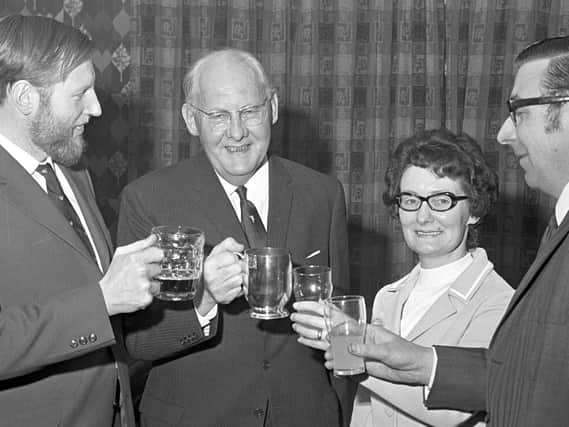Evenin' all... Former Advertiser reporter remembers Rugby's police in the 1960s


There was once a truly magnificent building that towered over two of Rugby’s streets, a veritable colossus that many people of a certain age will remember well.
Somehow or other, the theme tune of the 1950s television serial Dixon of Dock Green enters my head. Evenin’ all…
Advertisement
Hide AdAdvertisement
Hide AdNot that the central character played by the inimitable Jack Warner ever stood on the steps of this palace of the police to deliver his famous opening and closing sermons, of course.
So yes, you’ve guessed. We’re talking about the old Rugby Nick.
I was a regular visitor to this imposing edifice on the corner of Railway Terrace and Craven Road back in the mid to late 1960s. In those days, most young people learnt their chosen trade on the hoof, which is why I would accompany ‘Tiser chief reporter Len Archer when he kept his daily appointment with the duty sergeant.
“Mornin’ Len,” he’d say, while casting a lingering, suspicious eye over the young whippersnapper with a highly suspect Beatles haircut. Then out would come this hefty book, a ledger that recorded all the incidents that the local coppers had encountered in the previous 24 hours.
Advertisement
Hide AdAdvertisement
Hide AdThis tome was a real Pandora’s Box of major and minor crimes, mishaps, and general misfortunes that had befallen the good folk of Rugby in just the space of a day.
Back then, the local police seemed to investigate everything. Petty vandalism, poaching rabbits, grass fires where arson was suspected, pub landlords serving alcohol out of hours, cars parked during the hours of darkness not displaying sidelights, trespass on the railway, and every single case of burglary no matter how much had been stolen… you name it, and the boys in blue would be on to it.
In fact, house breaking was considered particularly newsworthy, which is why Len would decide that such an incident merited what we journalistic folk call a ‘follow-up’.
This entailed a reporter going round to the address and requesting an interview with the householder. And it might surprise you to learn that most people were only too happy to provide details of what had been stolen, as publicity would not only aid insurance claims, but also provide antique and bric-a-brac dealers with information about stolen goods.
Advertisement
Hide AdAdvertisement
Hide AdIt was quite remarkable what could be gleaned from just a little gentle and respectful probing. The theft of a much-loved family heirloom, the German pickelhaube helmet from the Great War, the purloined pearl necklace that had been a wedding present for great-aunt Mabel… a story lay buried beneath every burglary, just waiting to be unearthed.
The Rugby Police Station building also contained courtrooms one and two. As a young reporter, I often found myself sitting on the Press bench, scribbling away with my embryonic shorthand, noting every detail.
In those days, only relatively minor cases would be heard at Rugby’s courtrooms, more serious offences being tried at Warwickshire Assizes, later to become known as a Crown Court.
As I relate in my book Go and Make the Tea, Boy! I often not only recognised the person in the witness box but they also acknowledged me as well, sometimes waving or winking an eye.
Advertisement
Hide AdAdvertisement
Hide AdThis would invariably result in the chairman of the bench shooting me a very disapproving look. But the reality was that I knew plenty of Rugby’s local villains, so this was occasionally inevitable.
However, I should point out that many magistrates in those days were woefully ill-equipped to do such an important job. Today, magistrates are far better trained, but in the 1960s, the bench mainly comprised local big wigs who just wanted to add the magistracy to their tally of important positions in society.
In fact, there was one chairman – who shall remain nameless – who regularly fell asleep while evidence was being heard. And on more than one occasion, the court clerk was obliged to quietly remind this same person that the sentence they had just passed was only permissible in a higher court.
I have many memories of walking down Pinders Lane with Len Archer, turning right and then left into Railway Terrace, en route to the old cop shop on the corner.
Advertisement
Hide AdAdvertisement
Hide AdThen there were all the old characters, the other Rugby journalists of yesteryear who would convene for their daily rendezvous at this bastion of law and justice.
I can still see in my mind’s eye stalwarts such as the Leicester Mercury’s Fred Friend, Coventry Evening Telegraph reporters Hilary Thompson and John Hardeman, all hungry for the latest snippets that would soon be immortalised in newsprint.
The end came in 1998, courtesy of the demolition crew’s wrecking ball and scaffolding. And soon, all that was left was a host of memories for a rookie reporter who had once waited nervously at the duty sergeant’s desk eager to hear about Rugby’s transgressions great and small.
John Phillpott’s book Go and Make the Tea, Boy! about his days working on the Rugby Advertiser during the 1960s is published by Brewin Books of Redditch. It is available from bookshops and the internet.